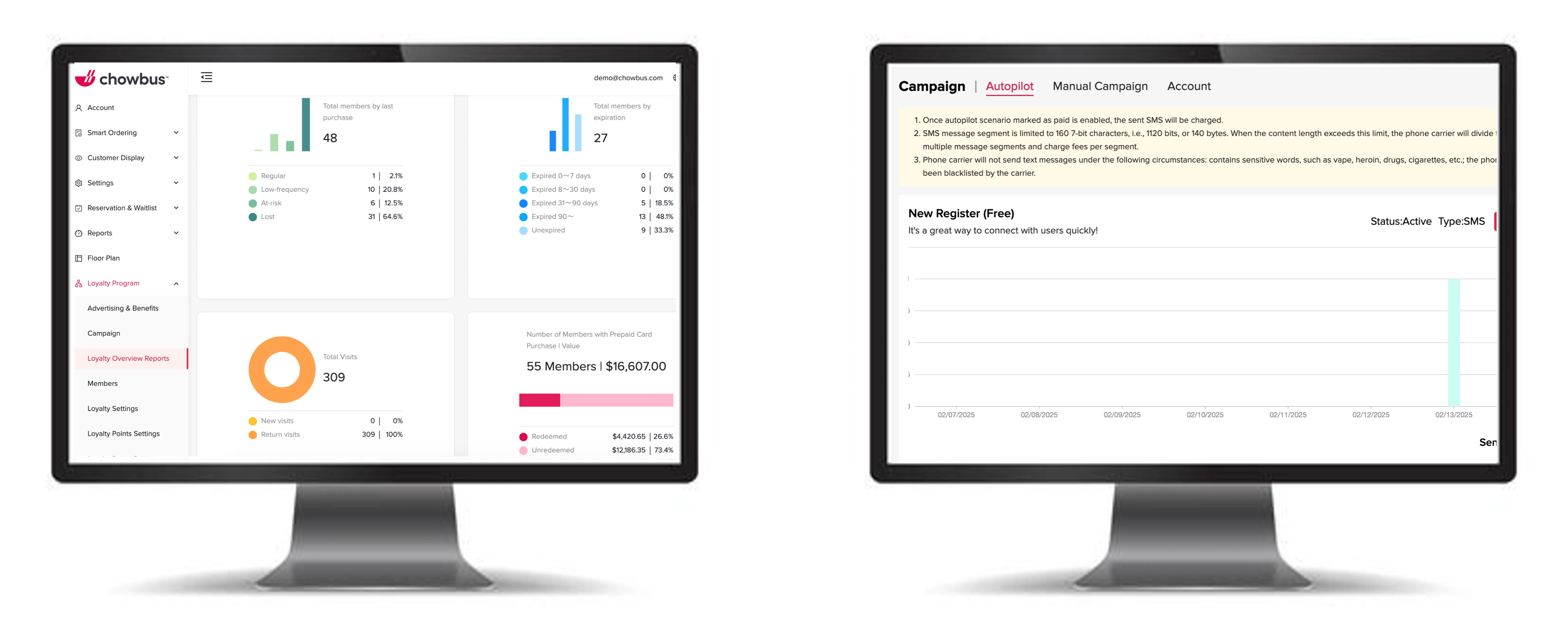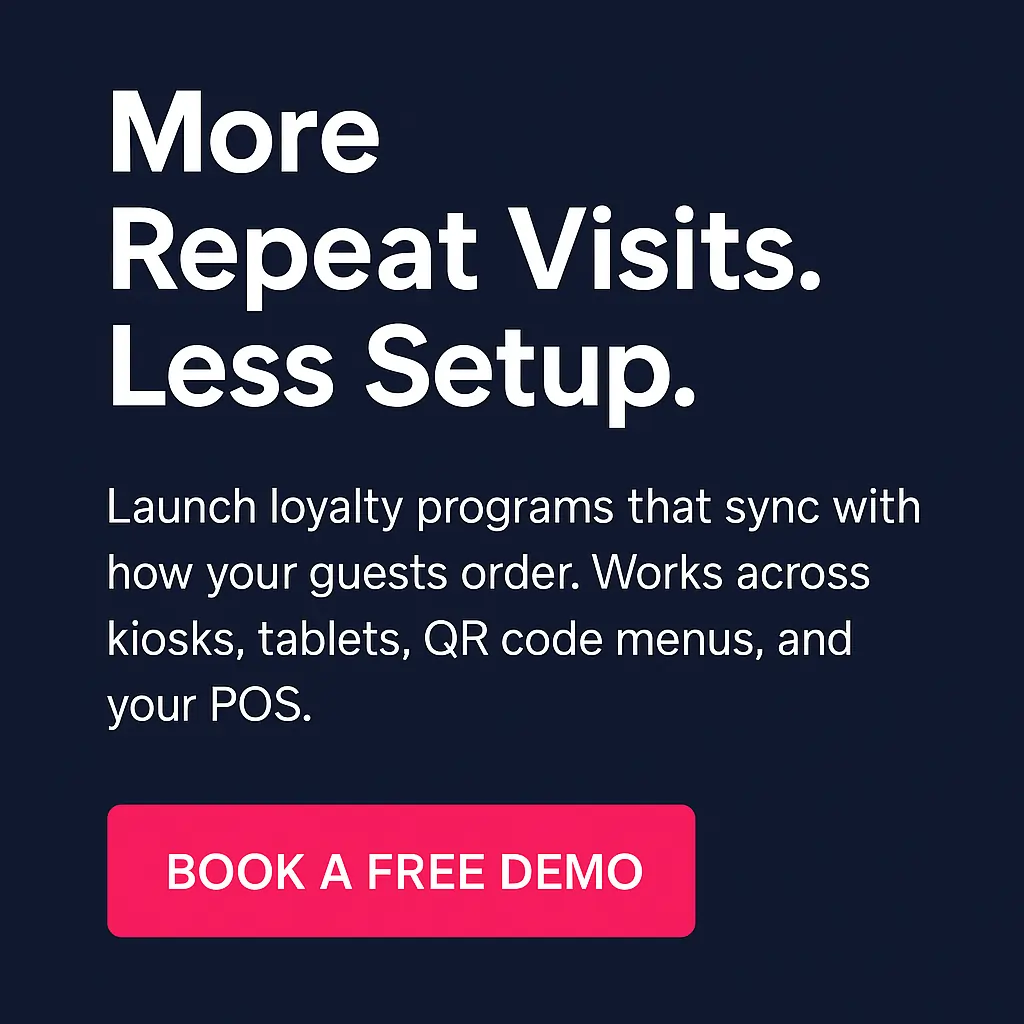
Loyalty programs are changing quickly. Diners expect more than points on a punch card. They want relevance, convenience, and real rewards. This shift creates new opportunities to boost repeat visits and spend.
This post highlights the loyalty program trends shaping the restaurant industry in 2025, giving you a clear view of what to implement next.

Guests expect more from loyalty programs than ever before. They want real benefits, delivered consistently and conveniently. As loyalty technology improves, new trends are shaping how restaurants attract, retain, and re-engage their best customers. The following seven focus areas highlight what to plan for in 2025 and beyond.
Generic rewards no longer drive loyalty. Guests want offers that reflect how they actually dine, what they order, when they visit, and how often they return. Personalized programs help you meet those expectations by responding to real behaviors instead of broad assumptions.
Using data from your POS and CRM systems, you can identify patterns and trigger tailored rewards in real time. That might mean sending a mid-week lunch offer to a guest who usually visits on Wednesdays, or a bonus points promotion to someone who recently increased their order size.
This level of personalization connects directly to the demand seen in customer loyalty trends 2025, where relevance often determines response. It also improves your ROI by focusing promotions on high-intent customers rather than spreading discounts too widely.
With an integrated loyalty setup, you can:
As loyalty program trends move toward smarter, data-driven strategies, personalization powered by real-time integration is becoming essential for sustainable customer retention.

Tiered loyalty programs are gaining momentum in the restaurant industry because they give guests a clear reason to return. These models offer structured rewards tied to milestones, such as total spend or number of visits, making rewards feel more meaningful and earned over time.
Instead of a one-size-fits-all approach, tiered systems reward commitment. As members progress to higher levels, such as Bronze, Silver, and Gold, they unlock increasingly valuable benefits, including higher point multipliers, early access to offers, and exclusive items. This sense of progression fosters stronger emotional loyalty and encourages repeat visits.
According to the Paytronix Annual Loyalty Report 2023, loyalty members spent approximately 5% more per check than non-members, and those who provided email addresses visited 25–50% more frequently, depending on the segment. These patterns show how even modest increases in loyalty engagement can drive meaningful revenue growth.
Here’s why tiered models work:
As more restaurants adopt tiered structures, these programs will continue to drive higher retention and ROI. They’re not just about rewarding spend, they’re about rewarding loyalty that builds over time.
Guests don’t think in terms of channels. They simply expect their experience to be consistent, regardless of how they place an order or interact with your restaurant. Loyalty programs now reflect that.
Omnichannel loyalty isn’t limited to mobile apps or online platforms. It connects every touchpoint where customers interact with your brand. The goal is simple: let guests earn and redeem rewards wherever they order, and keep their experience smooth from start to finish.
Here’s how effective loyalty programs are making that happen:
When loyalty data flows through every channel, you gain a full picture of customer behavior. That makes your marketing smarter and your promotions more effective. You can target based on real activity, send offers at the right time, and make every message feel more relevant.
Consistency builds trust. When guests see the same benefits wherever they order, they’re more likely to keep coming back. Omnichannel loyalty is no longer a feature. It’s the foundation of a reliable retention strategy.
Points with no immediate payoff won’t keep people coming back. Guests want rewards that feel tangible, fast, and easy to use. That’s why instant benefits are becoming one of the most important customer loyalty trends in 2025.
The moment a customer joins your program or completes a qualifying action, they expect something in return right away. That could be:
Delaying these benefits can reduce interest. Guests are more likely to stay engaged when the rewards feel real and timely.
Instant rewards also help drive behavior in specific ways. For example, sending a “Thank You” perk right after a dine-in purchase encourages a second visit, especially if the offer expires soon. You can use the same approach to boost slow weekday traffic, move seasonal items, or re-engage someone who hasn’t ordered in a while.
Many restaurants now tie these real-time perks to their POS and CRM systems so everything updates automatically. This not only improves the guest experience but also keeps the team focused on service rather than manual tracking.
Customer loyalty trends 2025 show a clear shift toward programs that reward people when the moment is right, while interest is still high and the next visit feels close. Keep it simple, visible, and fast. That’s what keeps guests coming back.
Game-like loyalty features are gaining traction for a reason: they keep customers interested. Points, badges, and challenges give people something to look forward to each time they visit. Instead of offering one-time rewards, gamification builds engagement over time. It encourages customers to interact more often and stay active in the program.
A few examples:
These tactics make the program feel more interactive and less transactional. They turn loyalty into an ongoing activity that customers enjoy, not just a passive point system.
Gamification also helps increase repeat purchases and creates more reasons to return. Instead of only spending when hungry, guests may visit again just to unlock a reward, finish a challenge, or maintain their streak.
As part of broader loyalty program trends in the restaurant industry, this approach works well when paired with a flexible POS system and integrated CRM. It’s easy to automate, easy to track, and easy for guests to understand. Simple game mechanics can lead to stronger connections—and stronger results.
In 2025, more guests will spend with brands that reflect their personal values. Loyalty programs now give you a way to turn those values into action. By building options that support sustainability and social good, you create a stronger emotional connection with your members and keep them engaged for longer.
Many restaurants are starting to:
This approach stands out among customer loyalty trends 2025 because it moves loyalty programs beyond transactional rewards. Guests feel they are part of something positive when they earn and redeem points. It also differentiates your brand from competitors who focus only on discounts.
Integrating these features into your loyalty program is straightforward when you align them with your POS and CRM systems. You can track participation, measure impact, and highlight results to your audience. By connecting rewards with meaningful actions, you strengthen brand reputation and inspire repeat visits from socially conscious diners.

Loyalty programs work best when they connect directly to your restaurant’s POS and payment systems. This integration allows you to enroll guests, apply rewards, and track redemptions all in one place—no extra hardware, no manual syncing.
Staff can easily look up a member, apply a discount, or log a point balance right at the register. That keeps service fast and consistent, even during peak hours. There's no need to train teams on multiple platforms or switch between tools.
With loyalty and POS working together, your data stays accurate and up to date. You can see how rewards impact sales, which promotions drive repeat visits, and where to adjust. Real-time insights help you fine-tune your strategy without delay.
For multi-unit operations, centralized reporting shows member activity across all locations. That consistency makes it easier to manage brand-wide campaigns and keep local execution aligned.
Here’s what this integration supports:
A connected loyalty system reduces work for staff and makes the experience better for guests. It also gives you better control, cleaner data, and clearer ROI.
Strong loyalty programs do more than retain customers; they provide people with a reason to return, spend more, and consistently engage with your brand. The most effective strategies in 2025 prioritize real-time rewards, flexible membership models, and seamless integration across channels. By focusing on these loyalty program trends, you can create meaningful customer relationships while keeping your operations efficient and data-informed.
Chowbus POS makes it easier to put these ideas into action. From free membership for quick service formats to top-up and annual plans designed for full-service dining, the system supports flexible loyalty options that work across all ordering channels. Guests can register in seconds, earn rewards instantly, and store their membership cards in Apple Wallet for easy access. Built-in CRM tools help you reconnect with past members through targeted messaging, while reporting dashboards give you a clear view of loyalty performance by location.
If you’re looking to attract new guests, boost repeat visits, and increase revenue without adding complexity, Chowbus can help.
Book a free demo with Chowbus POS today and see how a connected restaurant loyalty program can support your growth in 2025 and beyond.

Get clear, straight answers to the most common questions about modern loyalty programs and where they're headed. This section breaks down key trends and what they mean for your business.
The future of loyalty programs moves beyond simple points for purchases. Brands will leverage AI and data to deliver hyper-personalized experiences and valuable non-transactional rewards. These programs will integrate seamlessly into omnichannel customer journeys, prioritizing emotional connection and member exclusivity over traditional transactional benefits.
In 2025, the reward trend shifts from generic points to personalized, instant, and flexible value. Shoppers now demand rewards that feel personally curated, deliver immediate gratification, and offer meaningful choices beyond a standard catalog. This means programs are prioritizing hyper-personalized offers, instant cashback or digital perks, and versatile redemption options like experiential rewards or charitable donations.
Yes, younger generations highly value loyalty programs, but they expect more than just points. They prioritize instant rewards, personalized offers, and seamless mobile experiences. To earn their loyalty, programs must provide authentic value and align with their values, often favoring experiential rewards over traditional discounts.
The success rate of loyalty programs varies by industry and execution, but studies show that well-designed programs can boost customer spending by 12–18% and improve customer retention by up to 25%. Their effectiveness depends on delivering real value through personalization, ease of use, and ongoing engagement. Programs that align closely with customer preferences and behaviors tend to see the strongest results.
Loyalty programs now focus on personalization, real-time rewards, and emotional engagement. Brands use AI and data to tailor experiences, offer instant perks, and build deeper customer connections. Gamification, subscription benefits, and eco-friendly rewards are also trending.
Where can I learn more about restaurant loyalty program trends?
Check out our blog section for regular insights and updates on loyalty, marketing, and technology for restaurants.

Recommended Articles: